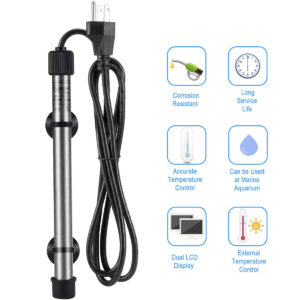How to Choose the Right Aquarium Heater
In cold areas, if you want to keep tropical fish, heaters are essential. The fish we raise in the aquarium naturally live in the warm waters of the central and southern United States, Southeast Asia, Africa, and Australia. The suitable water temperature is 20~30 ℃ throughout the year.
If you live in an area that cannot provide constant tap water temperature, then you must artificially adjust the temperature of the water in the aquarium to the most suitable temperature for the survival of the fish.
Integrated temperature control heating rod
The integrated temperature control heating rod is by far the most common equipment used for heating aquariums. It consists of a thermostat connected to a heating element and placed in an explosion-proof pipe. After the integrated temperature control heating rod is plugged into the power source, once the required temperature is set and put in the water, they will adjust the switch by themselves to control the heating.
Usually, there is a temperature-setting knob on the top of the heating rod, and some models have a temperature display to display the temperature you set. The heater heating wire is sealed in a cylindrical glass tube so that the heat can be transferred well, but the glass tube means that you must be careful when using it and not break it.
How does the aquarium heater work?
Traditionally, the integrated temperature control heating rod works by using a bimetallic sheet as a switch. This kind of metal sheet is composed of two pieces of metal tied together, one is steel and the other is copper. Due to the different heat conduction rates of the two metals, when exposed to heat, it will cause a certain metal strip to bend. One piece of metal is connected to the power supply, and the other piece is connected to the heating rod interface. When the heating is sufficient, the connection will be disconnected, and the connection will be re-established when the water cools, heating the water.
In a more modern way, in other words, a more reliable way, through the microchip to control the heating in the thermostat, the price of the microchip is higher than that of the bimetal strip, which is usually reflected in the price of the heater.
This is the application of new technology to the heater. Its material is composed of tough, not easily damaged materials, and it is more durable. It only needs to heat one element to reach the required temperature, and it is safer to control. An electronic display screen accurately displays the real-time water temperature and the set temperature, so that the water temperature can be monitored more accurately. Once a problem occurs, you will get to know it in no time.
Other types of heaters
Nowadays, there is a more common in-line heater on the market. The heater and the thermostat are separated and connected by wires. The heater and thermostat of this separate temperature control heating equipment can be purchased separately. The advantage is that the temperature controller placed outside the aquarium can adjust the temperature more conveniently. This kind of thermostat placed outside has a temperature probe to measure the water temperature.
The split thermostat can also control a larger heater, such as a 600-watt heater, or control two small heaters at the same time. Using the split thermostat you can choose heaters of any shape, any quality, and any size. Be careful when choosing heaters and thermostats, because poor-quality heaters may break down. If this happens, the damage to the seawater aquarium full of marine life can be too great. Would you give up a seawater aquarium with the value of a second-hand car for a heating rod whose value is only equivalent to a music CD?
Nowadays, titanium aquarium heaters are also appearing on the market. In terms of durability and quality, this heater is the best choice.
Built-in heater
The built-in heater is embedded in the external filter pipe to function, rather than placed in the aquarium. The advantage is that this heater will not scald the fish; it is hidden and is no longer a visual obstruction in the aquarium; you do not need to touch the water when adjusting the temperature. Another advantage is that the water flow can evenly distribute the heat throughout the aquarium. When the water stops flowing, some models even automatically shut themselves down.
More Tips
Do not remove the glass heater from the water if the glass heater has not been powered off or has just been powered off within 10 minutes. Otherwise, the glass will shatter. If you need to remove the heater, turn off the power for 30 minutes before you can move the heater out of the water.
External filters are often equipped with built-in heating elements and temperature controllers, which have many similarities with embedded heaters: heat can be evenly distributed into the water; the heater is placed outside the main aquarium to make the aquarium look more beautiful, The fish will not be scalded. There are constant temperature filters suitable for both freshwater aquariums and seawater aquariums on the market.
To protect the heater from impact and damage, please install a heater guard. These plastic protectors cover the heater and prevent the heater from being damaged while not hindering heat transfer.





